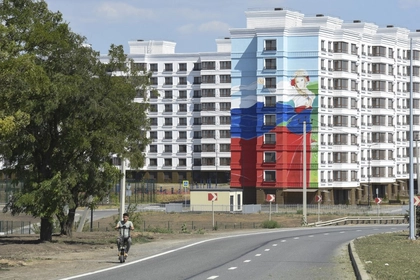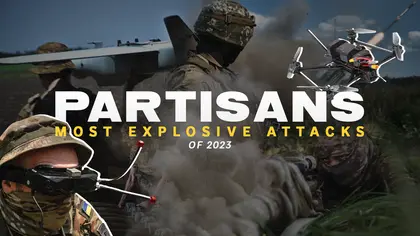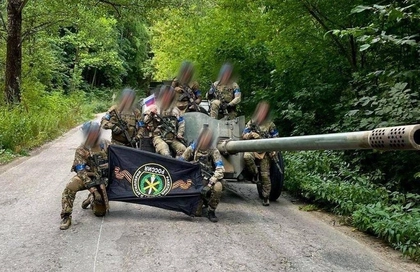The whole world has looked on in admiration as the Armed Forces of Ukraine (AFU) resisted the full-scale armed aggression of the “second army of the world.” It is not just the army that has defied Russia but Ukrainian civilians have also done their bit. Resistance against the occupying forces and their proxies has not only not diminished, but has become more widespread.
Ukrainian partisans have emerged to create serious difficulties for a strong and vicious enemy. They have attacked his collaborators, soldiers, communications, logistics and other strategically important facilities, forcing the decentralization and destabilization of his forces.
JOIN US ON TELEGRAM
Follow our coverage of the war on the @Kyivpost_official.
The actions of Ukrainian partisans have caused fear and panic among enemy troops, creating an uncertain operational environment, which has led to strategic planning failures and caused general uncertainty among the Russian military at every level.
In a wide-ranging interview with the Kyiv Post, representatives of these partisan groups have given us an idea of their successes and some of their failures throughout the year. They told how in 2023 their operations have moved on from their earlier tactical focus to a more strategic level. They now not only seek to eliminate individual Russians, but increasingly support strikes against decision-making centers - as was the case in the attacks on headquarters of the Russian Black Sea Fleet in Sevastopol.

Moscow Imposes Russian Car Insurance in Occupied Ukraine by 2025
“The occupiers could not even in their nightmares imagine the kind of resistance that will be formed in the Ukrainian territories they occupy. We are confident that this resistance will significantly undermine their ability to further occupy our territories and create opportunities for liberation,” the guerrillas’ spokesman exclusively told the Kyiv Post journalist.
Here, the Kyiv Post has compiled the top 10 most significant, high-profile, and unforgettable special operations conducted by Ukrainian partisans to make 2023 an especially “explosive” year.
- Strike against the Russian Black Sea Fleet HQ in occupied Crimea
On Sept. 22, Russia's Black Sea Fleet (BSF) headquarters in Sevastopol was hit by at least two Storm Shadow / SCALP missiles. The attack was reportedly carried out with the help of “Russian residents of Crimea” who provided information to the Ukrainian underground – who told the Kyiv Post at the time that those “citizens” were disgruntled Russian naval officers who had not received their pay on time.
One of the guerrillas told the Kyiv Post that information received from Russian informants was immediately passed on to Ukraine’s intelligence services - the SBU, the HUR and other relevant agencies.
“We contact representatives of various special services and they all get the information they need, which we can provide them with.”
This devastating attack on many of the commanders in the BSF was described by the spokesman for the Ukrainian Air Force, Yuriy Ihnat, as “not only a blow to the heart of the Black Sea Fleet, but a blow to Putin's dictatorship. Everyone will see this. It is impossible to hide it.”
This strike on the headquarters of the Russian Black Sea Fleet when members of its command group including its Commander-in-Chief were present contributed two months later to the Russian decision to move most of its fleet from the Crimean port in favor of safer bays in the port of Novorossiysk, in southern Russia.
- The destruction of Russian ships in Sevastopol shipyard
Storm Shadow / SCALP missiles struck again in the early hours of Early in the morning of Sept. 13, against the main shipyard in Sevastopol, destroying two important Russian vessels - the Rostov-on-Don submarine and the large landing ship Minsk.
At the time, the Crimean underground told the Kyiv Post that they had been obtaining information from local residents that allowed them to identify these important Russian military targets. Agents from various fields were involved: civilians, BSF servicemen, and employees of the shipyard, where one of the ships was under repair.
“A lot of information came from ordinary residents of Sevastopol, who constantly send us data about the enemy,” they said, adding that Russian forces in Crimea “fell victim to their own propaganda” because they “believed that all Crimeans support Russia.”
- HIMARS strike that killed 200 Russian troops on a beach in Kherson region
At the end of July, a large group of Russian soldiers gathered on a beach on the Dzharylhach Island in the Black Sea, in a training and rest camp far from the front line. While a large group, believed to be from five separate military units were standing on its sandy shore, their day was abruptly interrupted by a volley of five Ukrainian HIMARS missiles.
“Personnel and equipment at Dzharylhach were eliminated, also according to our underground,” Ostap, a spokesman for Ukraine’s National Resistance Center (NRC), exclusively told Kyiv Post shortly after the event.
The NRC estimated the death toll at around 200 people. According to wel-placed Ukrainian sources, the strike was carried out based on information provided by a local group of the underground operating in the occupied territory.
- Strike on the Russia’s Saki airfield in Crimea
For six months, Crimean-based guerrillas had been conducting constant reconnaissance of the Saki airfield, from which Russian troops regularly launched strikes on Ukrainian-controlled territory. As a result of the detailed information their scouting provided Ukraine mounted a combined drone and missile strikes against the target on Sept. 21 killing at least 30 Russian servicemen as well as damaging several aircraft and vital equipment.
The attack deployed drones to overload Russian air defense at the location enabling, and then Neptune missiles to be launched largely unopposed.
Kyiv Post's source in the SBU said that at least 12 Su-24 and Su-30 combat aircraft along with a Pantsir missile system (NATO name SA-22 Greyhound) were stationed at the airfield, which was also a training base for Mohajer UAV operators. “These are the drones used by the Russians to coordinate their own air attacks, as well as a combat drone,”said the SBU representative.
- Sabotage of elections in the temporarily occupied territories
Russian authorities held pseudo-elections in the temporarily occupied territories of Ukraine from Sept. 7 – 10 which they saw a s a referendum on remaining part of Russia. Ukrainian guerrillas carried out a number of actions to disrupt the smooth running of the sham elections.
This ranged from posting leaflets calling on local residents to ignore the elections to passing targeting information on those involved in the elections to Ukraine’s Defense Intelligence Agency (HUR) and its Security Service (SBU). This saw two drone attacks, one against a polling station in Zaporizhzhia and the other against a vehicle carrying ballots and three Russian military political workers in Luhansk
“Elections here ended prematurely,” an SBU source told Kyiv Post. “After the explosions, the occupiers got nervous — they surrounded the nearby streets, started checking people, and launched their drones in the air.”
“Some of the names of collaborators and traitors, as well as occupants involved in the organization of these pseudo-elections have been worked out, and some have already been eliminated. We are also working on the rest of them,” HUR representative Andriy Yusov told Kyiv Post exclusively.
- Poisoning of Russian soldiers in occupied territories
On several occasions Ukrainian guerrillas have poisoned Russians by lacing “gifts” of food and alcohol with arsenic and rat poison which, up to now, the enemy has been happy to accept.
On Oct. 16, the advisor to the mayor of Mariupol, Petro Andriushchenko, said that over 40 Russian soldiers had been poisoned during dinner in Mariupol, of those 26 died and 15 more admitted to intensive care.
A Kyiv Post sources from the Mariupol partisan group confirmed the poisoning was the result of a planned action, after that had lasted several weeks.
“The poisoning operation became possible only because there was a rotation. The people [there] are different,” the source said.
"They were fed poison. The cooks are now safe, as are their families."
“We are helping as much as we can: we will spy on a warehouse somewhere, a racket will fly to the headquarters somewhere, we will leave poisoned vodka somewhere, we will help with food somewhere, a car will suddenly explode somewhere...” added the Mariupol partisans.
This “unforgettable dinner” was not a one off. At the end of November, a group of FSB officers ordered food and alcohol from a restaurant in occupied Melitopol. The meal they received contained a huge quantity of poison that killed three of officers soon after being admitted to hospital, with the fourth was fighting for his life in intensive care.
The restaurant where the food was prepared was searched, but no traces of poison were found. However, the courier who made the delivery had disappeared without a trace.
In early December “two lovely girls” treated Russian soldiers in a military unit in Crimea with sweets and vodka to “thank our guys for everything, for protecting them”. The soldiers readily accepted the gesture but these also contained a huge dose of arsenic - it was the last dinner for 24 Russians.
- Destruction of Russia's important strategic rail links
The railway plays a key role in the logistic support to military operations and are of strategic importance. They are, therefore, prime targets for guerrillas in both the occupied territories of Ukraine and in the Russian hinterland.
On June 11, Ukraine reported that guerrillas in the occupied part of Zaporizhzhia region blew up a railroad bridge that the occupiers used to transport weapons and supplies from Crimea.
On the night of Nov. 30, acting on information from the Ukrainian underground, SBU agents conducted a special operation to blow up a train as it passed through the Severomaiskyi Bessolov tunnel in Buryatia. This was in the Asian part of the Russian Federation (Baikal-Amur Mainline) which is the mainline link between Russia and China.
“Currently, this route is used by the Russians, among other things, for military supplies. After the explosion, it was paralyzed,” a military source told the Kyiv Post.
A few days later, another freight train using a part of the mainline to bypass the blocked tunnel , was also blown up blocking the track on this alternate route.
“The Russians have fallen into the SBU's trap twice - another train carrying fuel has exploded on the Baikal-Amur railroad," the source said.
This explosion was the second stage of the SBU's special operation to disable this important railroad line, which is used by Russians for military logistics.
On October 13, in occupied Melitopol, guerrillas themselves blew up a Russian train that was transporting ammunition and fuel from Crimea to Melitopol and Dniprorudne and damaged equipment. The line is also used by the Russians to take stolen iron ore, grain and other property in the opposite direction.
The partisans remind us that control of the railroad infrastructure is essential for the strategic success of military operations.
- Booby-trapped vehicles
Ukrainian guerrillas seek to not only eliminate ordinary soldiers in large numbers every day, but also high-ranking officers of the Russian army. One of the most popular methods of eliminating Russian officials is to blow them up in their cars.
On Nov. 8, Mikhail Filiponenko, a member of the so-called "people's council" and former head of the “people's police” of the so-called Luhansk People’s Republic (LNR) was killed when an explosive device functioned in his car. Kyiv Post contacts reported that Filiponenko's death was the work of the Ukrainian underground.
Then on Nov 10 which was Russia's Police Day, Mariupol partisans planted a device in the car of a Russian police officer who died on the spot after the bomb exploded under the
the hood of the car.
“The blast was caused by improvised explosive device, as we have enough of them in the city,” Mariupol partisans told the Kyiv Post.
The target had been a “policeman who was involved in the so-called filtration” – the process used to register, interrogate, and detain Ukrainian citizens in regions under Russian occupation.
On Dec 6, the car belonging to Oleg Popov, “a deputy of the People's Council and head of the Committee on State Security and Defense” of the LNR, exploded close to Luhansk’s city stadium.
A Kyiv Post source said that Popov was “a legitimate target, because before becoming a deputy, he was in charge of many Russian volunteer battalions, headed illegal armed groups and killed Ukrainians.”
“The explosion of the head [of the committee] is the best advertisement for the effectiveness of this committee,” the source said.
- Destruction of Russian S-400 Triumf anti-aircraft missile system in Crimea
On Sept. 14, SBU military counterintelligence and the Navy launched a combined strike against a Russian air defense base near Yevpatoriya thanks to intelligence furnished by Ukrainian partisans.
First, SBU drones hit the radar stations associated with the complex after which the Navy struck the S300/400 Triumf launchers with two Ukrainian-made Neptune cruise missiles.
The S-400 is a modernized version of the S-300 with a range of 400 kilometers. It is designed to engage air targets: strategic and tactical aircraft, ballistic and hypersonic missiles, reconnaissance aircraft, and drones.
- Destruction of the Russian army communication complex in Kherson region
On June 26, a single guerrilla infiltrated a Russian unit in the Kherson region and set fire to the P-161 communication complex located there which was destroyed.
The importance of the complex was in providing military forces with the means to exchange information, coordinate actions and manage combat operations.
A new unit had arrived in the settlement where an agent of the ATESH partisan movement, a Russian military officer, was located. According to the partisans, he waited until his military colleagues who were constantly drinking got drunk then carried out the arson attack.
This remarkable list of successful operations of Ukrainian partisans is not the end of their planned activity. Their numbers continue to grow and they plan to continue their activities for a long time. They intend to prepare “new surprises” for the occupation forces in the coming year.
“We are preparing many “surprises” for the rashists. We are sure that many occupiers will not survive them. Our struggle will continue until the complete liberation of Ukraine," the guerrillas added in a conversation with Kyiv Post.
You can also highlight the text and press Ctrl + Enter






